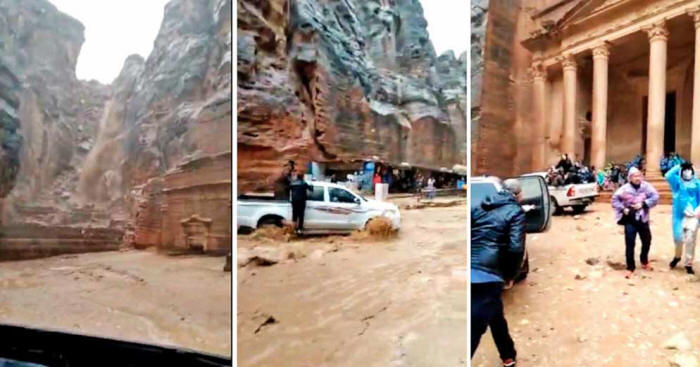|
Scenes of the evacuation and flood of Petra historic site. Source: Twitter Screenshot
A whopping 66 millimeters of precipitation (0.21 feet) struck the site on Tuesday morning, with footage emerging of water washing into the entrance of Petra's rock temple, and a bus tipping over due to the torrential rainwater.
The rainfall, emanating in the southern part of the country, aided by the surrounding mountains, cascaded down into the rose-colored city, caused widespread floods, reports Al-Monitor.
The aforementioned bus was en route the Al-Hussein Bin Talal University, with 3 people injured in the accident, according to the primary emergency operations center in the city.
Several videos emerged of the ancient rock-cut Nabatean temple, dubbed 'the Treasury', with water flooding down its sides.
It is one of the most visible fronts of the sprawling 260 kilometer square site that is located 30 kilometers (19 miles) northwest of Ma'an.
These clips show bewildered and panicky looking tourists packed into pick-up trucks from the site's narrow passages, including the Siq, which resemble rivers (Siq).
Petra - 'Rose City' With a Rich History
Petra, renowned for its intricate rock-cut architecture is a UNESCO World Heritage Site since 1985, and no stranger to floods, reports The Greek Reporter.
These floods have historically shaped the site's history and landscape over the centuries.
Petra, also known as the 'Rose City' for its red stone, has been standing for 2,000 years, carved by the Arab Bedouin tribe the Nabateans, in the 2nd century AD.
They directly worked into the pink-red sandstone cliff, and includes burial chambers, which caused it to be elevated to the status of one of the Seven Wonders of the World.
It was a thriving trading center, amassing wealth for the tribe, inviting the attention of neighboring empires.
The natural landscape and the terrain provided a cover from attacks, but it finally succumbed to the Roman Empire, and then the Byzantines, who would control the region till they faced defeat at the hands of the Islamic caliphates.
The city was abandoned and rediscovered in the 1800s by Swiss explorer Johann Ludwig Burckhardt.
Every year, Jordan attracts hundreds of thousands of tourists to experience its rich cultural heritage and material history of temples and mausoleums, with a great footfall reported this year due to the two-year COVID enforced absence.
Rain, Rain, Everywhere - From Jordan to UAE
The warning bugle had been sounded by Raed Khattab, the director of the Jordan Meteorological Department.
He further indicated that the southern governates are likely to get the greatest amount of precipitation. On the weekend, landslides and rockfall on the road running along the Dead Sea had also struck the countryside.
In fact, it was just in 2014 that an alarm system and a dam had been installed in the area by the Jordan's Department of Antiquities to warn against flooding and organize a better flood mechanism system for the safety of all those concerned.
The dam was especially built to keep water out of the nearby area of the treasury, reports The Middle East Eye.
In 2018, it was unable to help prevent flooding in the same location as now, which resulted in the unfortunate death of 13 people, and the evacuation of 4,000 people.
In 1963, 22 French tourists and their Jordanian tour guide had died as a result of sudden flash floods.
The Western Asia and Arabian Peninsula area, known to the west as the Middle East, has been hit by untimely floods all around. Flash floods hit Saudi Arabia's Mecca on Friday, a vital pilgrimage site for Muslims all across the world.
The torrential rain that happened overnight damaged vehicles and properties in the holy city. Rain hit Baghdad and other areas in Iraq on Saturday, with municipal workers seen pumping water from the streets of the capital.
Even parts of the United Arab Emirates (UAE) were flooded, including Gaza and Egypt's Alexandria.
References
|


